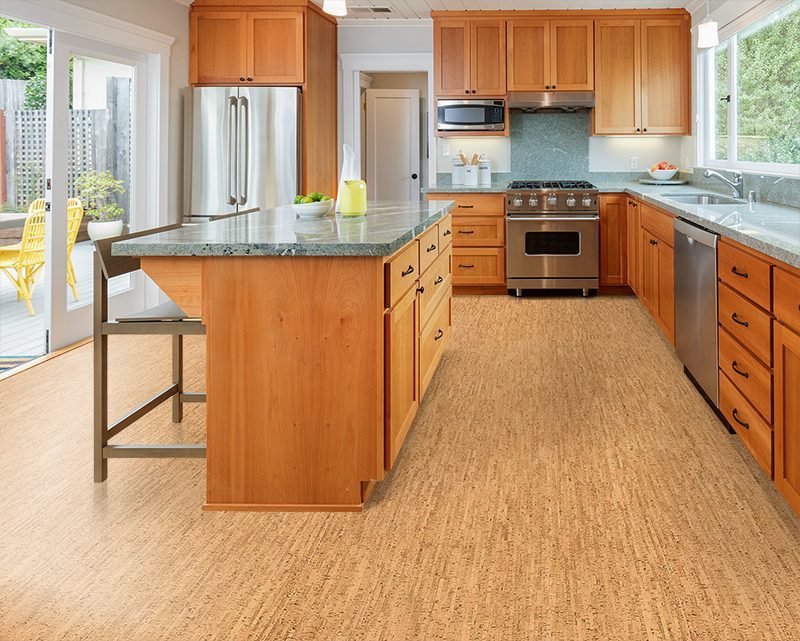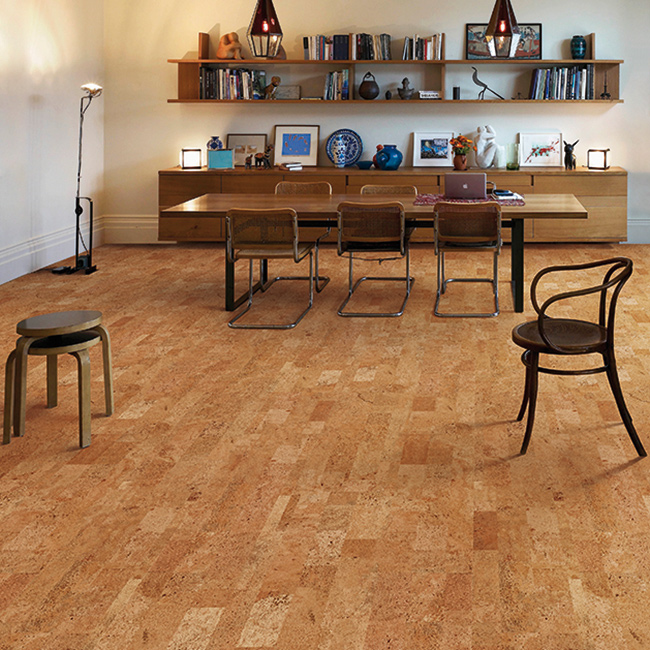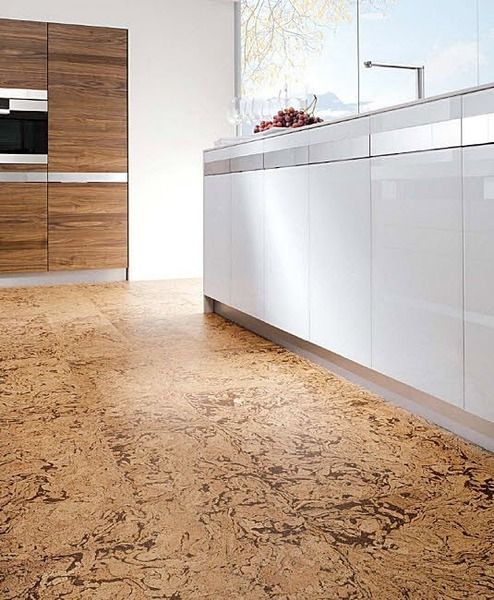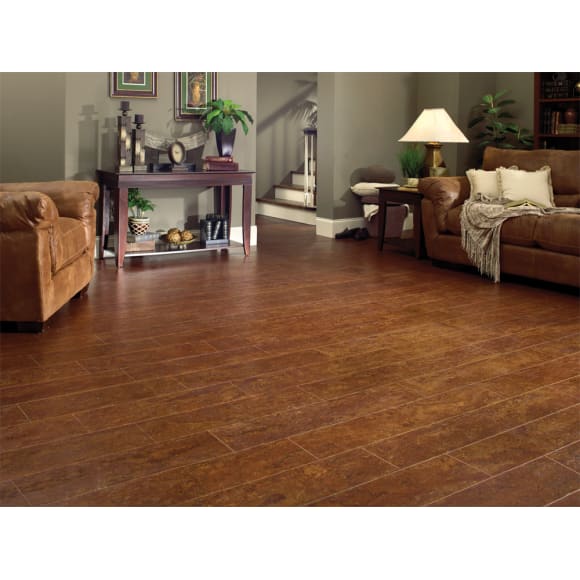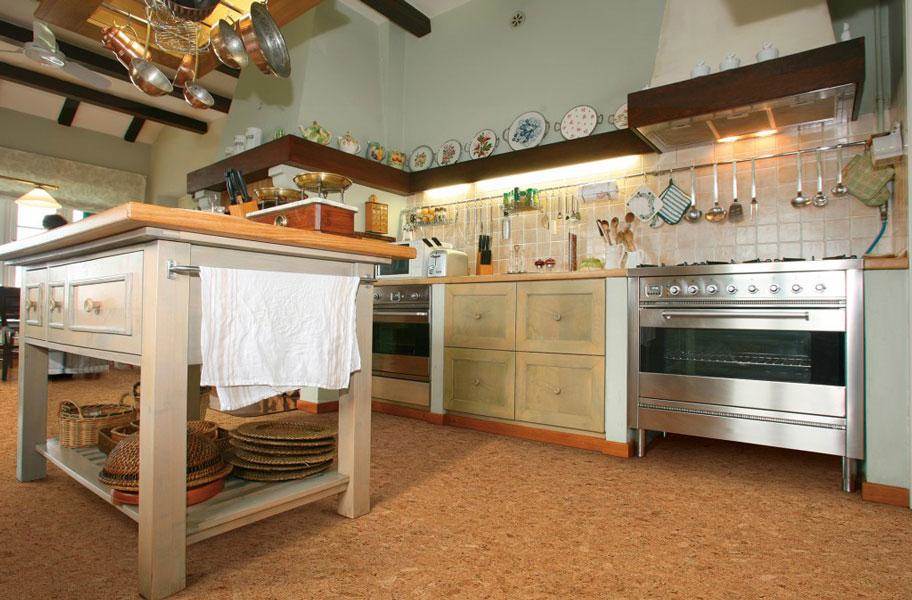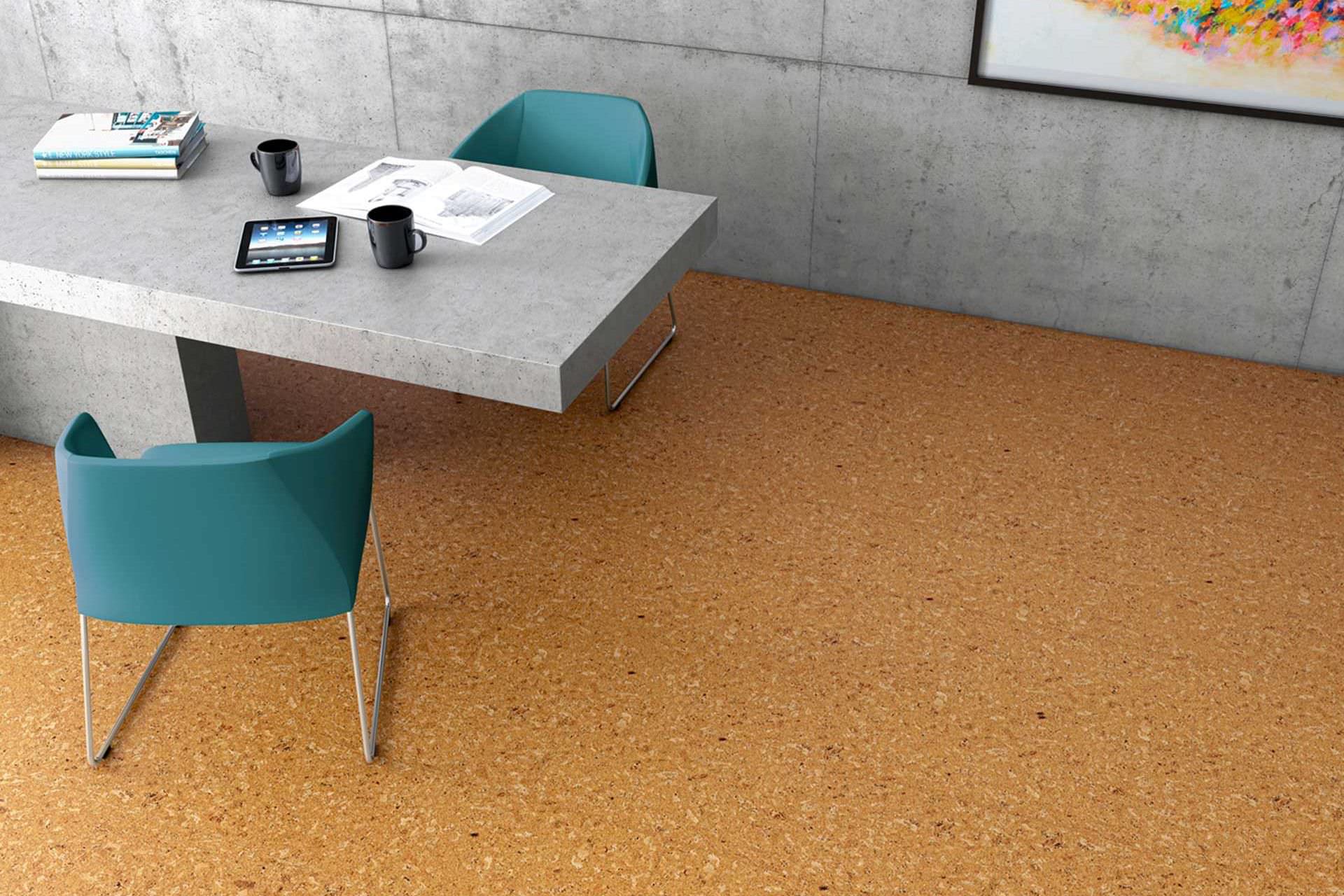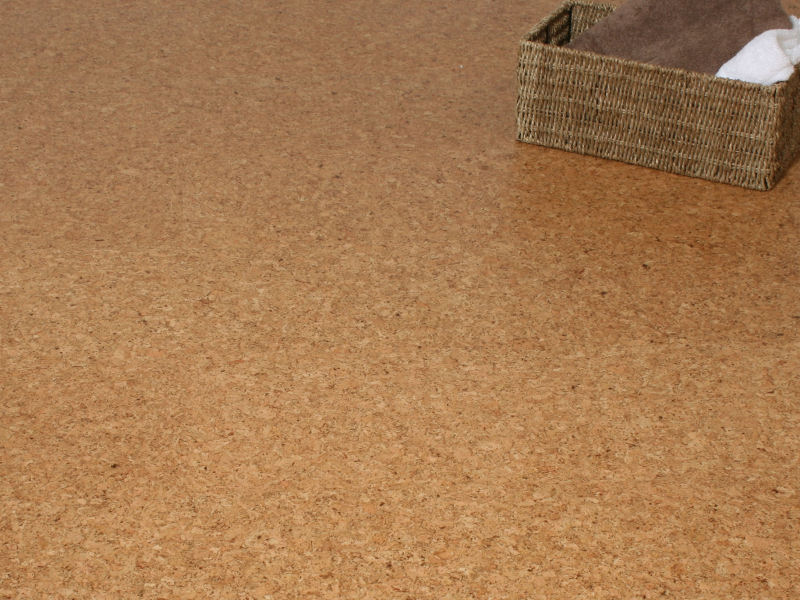Why Choose Natural Cork Flooring: A Sustainable and Stylish Option
Natural cork flooring is gaining popularity as a versatile and eco-friendly flooring option, offering a unique combination of sustainability and style. Here’s why you should consider natural cork flooring for your home.
- Eco-Friendly and Sustainable: One of the primary reasons homeowners choose cork flooring is its sustainability. Cork is harvested from the bark of the cork oak tree, which naturally regenerates after harvesting, making it a renewable resource. Unlike other flooring materials that require the destruction of trees, cork can be harvested without harming the tree, allowing it to live and grow for many years. This makes cork an environmentally responsible choice that contributes to the preservation of forests.
- Natural Insulation Properties: Cork flooring provides excellent thermal and acoustic insulation, making it a comfortable and quiet option for your home. The cellular structure of a cork contains millions of tiny air pockets that trap heat and sound. This means that cork floors stay warm underfoot, even in cooler climates, and help reduce noise levels, making your home more peaceful and energy-efficient. The insulating properties of cork can also lead to lower energy bills, as it helps maintain a consistent indoor temperature.
- Durable and Resilient: Despite its soft and cushiony feel, cork is surprisingly durable and resilient. The natural elasticity of cork allows it to recover from minor impacts, making it resistant to dents and scratches. This resilience makes cork flooring ideal for high-traffic areas in your home, such as the kitchen or living room. Additionally, cork is naturally resistant to mold, mildew, and pests, ensuring that your flooring remains in good condition for many years with minimal maintenance.
- Hypoallergenic and Healthy: Cork flooring is an excellent choice for those with allergies or sensitivities, as it is hypoallergenic and does not release harmful chemicals or allergens into the air. Cork is also naturally resistant to dust mites and other common household allergens, making it a healthier option for indoor environments. Furthermore, cork floors do not have off-gas volatile organic compounds (VOCs), which are commonly found in synthetic flooring materials and can contribute to indoor air pollution.
- Aesthetically Versatile: Cork flooring offers a unique and natural aesthetic that can complement a variety of interior design styles. Available in a range of colors, patterns, and textures, cork can mimic the appearance of hardwood, stone, or even tile, providing you with numerous design possibilities. Whether you prefer a modern, minimalist look or a warm, rustic feel, cork flooring can be tailored to suit your taste and enhance the overall look of your home.
- Comfort and Safety: The soft and cushioned nature of cork flooring provides a comfortable surface to walk on, reducing fatigue and strain on your feet, legs, and back. This makes cork an ideal choice for areas where you spend a lot of time standing, such as the kitchen. Additionally, cork flooring is slip-resistant, providing a safer surface for homes with children, elderly individuals, or pets. The combination of comfort and safety makes cork flooring a practical and appealing option for any home.
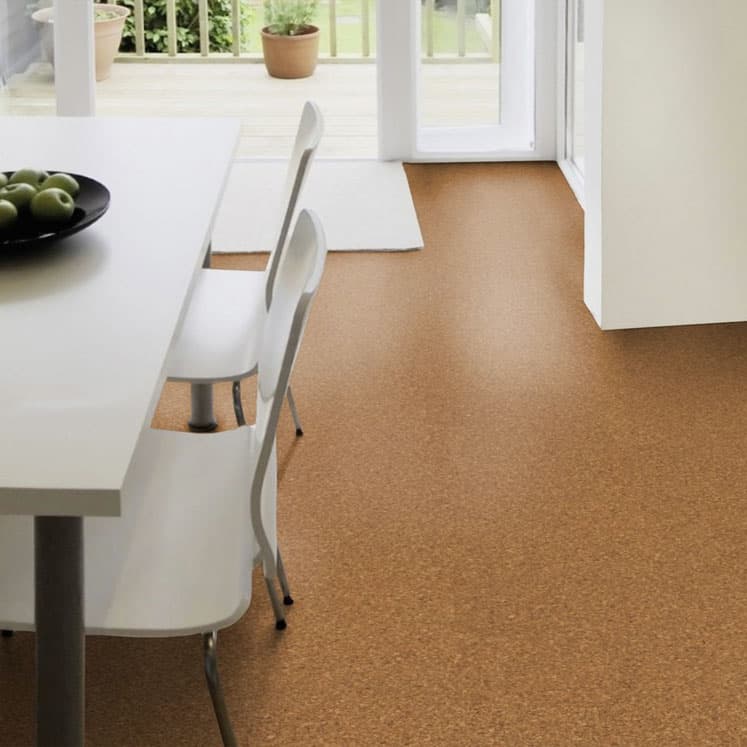
Exploring Different Styles of Natural Cork Flooring for Your Home
Natural cork flooring offers a variety of styles that can suit any home décor, making it a versatile choice for modern and traditional interiors alike. Here’s a look at some popular styles of cork flooring that you can explore for your home.
Traditional Cork Flooring
Traditional cork flooring typically features a natural, earthy appearance that highlights the unique grain patterns and textures of the cork material. This style is ideal for homeowners who want to emphasize the organic qualities of cork, creating a warm and inviting atmosphere. Traditional cork flooring works well in rustic or eco-friendly home designs and can be paired with natural wood furnishings and neutral color palettes to enhance its natural beauty.
Cork Flooring with Wood-Look Finishes
For those who love the look of hardwood but want the benefits of cork, wood-look cork flooring is an excellent option. This style features cork planks that are printed with realistic wood grain patterns, mimicking the appearance of popular hardwood species such as oak, maple, or walnut. Wood-look cork flooring combines the aesthetic appeal of hardwood with the comfort and sustainability of cork, making it a popular choice for living rooms, bedrooms, and kitchens.
Patterned Cork Flooring
Patterned cork flooring adds a touch of creativity and visual interest to any room. This style features intricate designs and geometric patterns that are either printed or inlaid into the cork material. Whether you prefer a subtle herringbone pattern or a bold geometric design, patterned cork flooring can make a statement in any space. It’s particularly well-suited for modern or eclectic interiors, where it can serve as a focal point and add a unique element of style.
Textured Cork Flooring
Textured cork flooring offers a tactile experience that enhances the natural feel of the material. This style may include hand-scraped, brushed, or embossed textures that give the surface a more rustic or artisan appearance. Textured cork flooring can add depth and character to a room, making it an excellent choice for spaces that aim to evoke a cozy and lived-in atmosphere. The texture also provides additional slip resistance, making it practical for homes with children or pets.
Cork Flooring with Metallic Finishes
For a more contemporary and sophisticated look, cork flooring with metallic finishes can add a touch of glamour to your home. These finishes incorporate metallic pigments into the cork material, creating a subtle shimmer or sheen that catches the light and adds a luxurious feel. Metallic cork flooring is perfect for modern, industrial, or chic interiors where a touch of elegance is desired. It can be used to create a striking contrast with matte or neutral elements in a room.
Cork Tile Flooring
Cork tile flooring offers a modular approach to design, allowing homeowners to create custom patterns and layouts. Cork tiles come in various shapes and sizes, including squares, rectangles, and hexagons, providing endless design possibilities. This style is ideal for those who want to experiment with different layouts, such as checkerboard patterns or herringbone arrangements. Cork tiles can be used to create unique flooring designs that reflect your style and creativity.
Best Rooms in Your Home to Install Natural Cork Flooring
Natural cork flooring is a versatile option that can be installed in various rooms throughout your home. Here’s a guide to the best rooms for cork flooring and the benefits it offers in each space.
Living Room
The living room is a central gathering space in the home, and cork flooring is an excellent choice for this area due to its comfort and durability. Cork provides a warm and inviting surface that’s perfect for lounging, entertaining, or spending time with family. Its natural insulation properties help to maintain a cozy atmosphere, while its resilience ensures it can withstand the wear and tear of daily use. Cork flooring also reduces noise, making it ideal for creating a peaceful living environment.
Kitchen
The kitchen is another area where cork flooring excels. Kitchens are often high-traffic zones, and cork’s durability and ease of maintenance make it a practical choice. Its soft and cushioned surface provides comfort underfoot, which is especially beneficial when standing for long periods while cooking. Additionally, cork’s natural resistance to water and stains makes it suitable for the kitchen environment. To further protect the flooring, consider applying a sealant to prevent moisture from seeping into the cork.
Bedroom
In the bedroom, cork flooring offers a quiet and comfortable surface that enhances relaxation and sleep. Its natural warmth and softness make it ideal for barefoot walking, while its hypoallergenic properties create a healthier sleeping environment. Cork’s ability to reduce noise transmission is also beneficial in bedrooms, ensuring a peaceful and restful space. The aesthetic versatility of cork allows it to complement a wide range of bedroom styles, from modern to traditional.
Home Office
Cork flooring is an excellent choice for a home office, where comfort and productivity are key. The cushioned surface of cork reduces fatigue, making it easier to stand or sit for extended periods while working. Cork’s noise-reducing qualities also help to create a quiet and focused workspace, minimizing distractions. Additionally, the natural look of cork can add warmth and character to a home office, making it a more inviting place to spend time.
Basement
Basements can be challenging spaces to the floor due to moisture and temperature fluctuations. However, cork flooring’s natural resistance to mold, mildew, and moisture makes it a viable option for basements. Cork’s insulating properties help to keep the space warm, which is especially important in cooler climates. When installing cork flooring in a basement, it’s important to ensure the subfloor is properly prepared and a moisture barrier is in place to prevent any potential water damage.
Children’s Playroom
Cork flooring is a great option for children’s playrooms due to its softness and safety features. The cushioned surface provides a forgiving landing for little ones who may fall or tumble during playtime. Cork’s hypoallergenic properties are also beneficial in a playroom setting, as they help to create a healthier environment for children. Additionally, cork is easy to clean, making it simple to maintain a tidy and safe space for kids to enjoy.
Natural Cork Flooring Colors: How to Choose the Right Shade for Your Space
Choosing the right color for your natural cork flooring is essential to achieving the desired look and feel of your space. Here are some tips to help you select the perfect shade for your home.
Consider the Room’s Lighting
The amount of natural and artificial light in a room plays a significant role in how the color of your cork flooring will appear. In rooms with abundant natural light, lighter shades of cork can help to enhance the brightness and create an airy feel. Conversely, in rooms with limited natural light, darker shades of cork can add warmth and coziness. It’s important to test samples of cork flooring in the room’s lighting conditions before making a final decision to ensure the color complements the space.
Coordinate with Existing Décor
When choosing a color for your cork flooring, it’s essential to consider the existing décor in the room, including furniture, wall colors, and accessories. For a cohesive look, choose a cork flooring color that complements or contrasts with the room’s color scheme. For example, if your room features neutral tones, a light or medium shade of cork can create a harmonious and balanced look. On the other hand, if you want to make a bold statement, opt for a darker shade of cork that contrasts with lighter furnishings.
Think About the Room’s Purpose
The function of the room should also influence your color choice. In high-traffic areas such as the kitchen or living room, medium to dark shades of cork may be more practical, as they can hide dirt and scuffs more effectively. In bedrooms or home offices, where a calming atmosphere is desired, lighter shades of cork can contribute to a serene and relaxing environment. Consider how the color of the cork flooring will impact the room’s overall ambiance and functionality.
Assess the Room’s Size
The size of the room is another factor to consider when selecting a cork flooring color. Lighter shades of cork can make small rooms feel more spacious and open, while darker shades can add depth and intimacy to larger spaces. If you’re working with a small room, a light-colored cork floor can help to visually expand the space, making it feel larger than it is. In larger rooms, a darker shade of cork can create a cozy and inviting atmosphere without overwhelming the space.
Explore Different Color Variations
Natural cork flooring is available in a range of colors, from light beige and honey tones to rich browns and deep charcoal hues. Some cork flooring options also feature color variations and patterns that add visual interest and character to the floor. Don’t be afraid to explore different color variations and patterns to find the one that best suits your style and the room’s design. Keep in mind that natural cork may change color slightly over time, especially when exposed to direct sunlight, so choose a shade that will age gracefully.
Consider the Overall Design Style
The overall design style of your home should guide your choice of cork flooring color. For a modern or minimalist look, consider light or neutral shades of cork that create a clean and uncluttered appearance. If your home has a more traditional or rustic style, darker shades of cork with rich, earthy tones may be more appropriate. The right color choice can enhance the design aesthetic of your space and create a cohesive and visually appealing environment.
Combining Natural Cork Flooring with Other Design Elements
Natural cork flooring can be seamlessly integrated with various design elements to create a cohesive and stylish interior. Here’s how to combine cork flooring with other design features in your home.
Pairing Cork with Wood
Cork flooring and wood elements complement each other beautifully, creating a warm and natural aesthetic. Whether you have wooden furniture, cabinetry, or wall paneling, cork flooring can enhance the organic feel of the space. To achieve a balanced look, consider the tones of the wood and cork. For example, light-colored cork flooring pairs well with lighter wood tones, while darker cork can add contrast to medium or dark wood finishes. This combination works particularly well in rustic, farmhouse, or Scandinavian-inspired interiors.
Mixing Cork with Modern Materials
For a contemporary look, cork flooring can be combined with modern materials such as glass, metal, and concrete. The natural texture and warmth of cork provide a striking contrast to the sleek and cool surfaces of these materials. For instance, a cork floor can soften the industrial feel of a space with concrete countertops or metal accents. In modern or minimalist interiors, the juxtaposition of cork with modern materials adds visual interest and depth, creating a space that feels both inviting and sophisticated.
Incorporating Textiles with Cork Flooring
Textiles play a crucial role in enhancing the comfort and coziness of a room with cork flooring. Rugs, curtains, and upholstered furniture can add layers of texture and color, complementing the natural look of cork. In living rooms, a plush area rug can anchor the space and provide additional softness underfoot, while in bedrooms, fabric headboards and bedding can create a harmonious and comfortable environment. Choose textiles in complementary colors and patterns to create a cohesive design that enhances the natural beauty of the cork flooring.
Using Cork in Open-Concept Spaces
In open-concept homes, cork flooring can be used to unify different areas, creating a seamless flow between spaces. The consistent use of cork flooring throughout an open-concept layout can visually connect the living room, kitchen, and dining areas, making the space feel larger and more cohesive. To differentiate zones within the open space, consider using area rugs or changes in furniture arrangement while maintaining the continuity of the cork flooring. This approach helps to create distinct areas within the open layout without sacrificing the overall unity of the design.
Enhancing Cork with Natural Elements
Incorporating natural elements such as plants, stone, and natural fibers can further enhance the organic appeal of cork flooring. Indoor plants add a touch of greenery and life to the space, while stone accents, such as a fireplace surround or decorative wall, can complement the earthy tones of cork. Natural fiber accessories, such as jute rugs or wicker baskets, can add texture and warmth, reinforcing the connection to nature. This combination of cork flooring with natural elements creates a serene and harmonious environment that brings the outdoors in.
Balancing Cork with Bold Colors and Patterns
While cork flooring has a natural and understated appearance, it can be paired with bold colors and patterns to create a dynamic and vibrant interior. For example, colorful wall art, patterned throw pillows, or a statement piece of furniture can add personality and energy to a room with cork flooring. The neutral tones of cork provide a versatile backdrop that allows bold elements to stand out without overwhelming the space. This approach is ideal for those who want to make a design statement while maintaining a sense of balance and harmony.
Installation Tips for Achieving the Perfect Natural Cork Floor
Proper installation is key to achieving a flawless and long-lasting cork floor. Here are some essential tips to help you install cork flooring in your home.
Prepare the Subfloor
The first step in installing cork flooring is to ensure that the subfloor is properly prepared. The subfloor should be clean, dry, and level to provide a stable foundation for the cork tiles or planks. Any imperfections, such as cracks or uneven areas, should be repaired before installation. In some cases, a moisture barrier may be necessary to prevent moisture from seeping into the cork, especially in areas like basements or kitchens. Taking the time to properly prepare the subfloor will help to ensure a smooth and successful installation.
Acclimate the Cork Flooring
Before installation, it’s important to allow the cork flooring to acclimate to the room’s temperature and humidity levels. This typically involves leaving the unopened boxes of cork flooring in the room for at least 48 hours. Acclimating the cork helps to prevent expansion or contraction after installation, which can lead to gaps or buckling. During this time, it’s also a good idea to check the room’s humidity levels, as excessive humidity can affect the performance of the cork flooring.
Plan the Layout
Planning the layout of the cork flooring is crucial to achieving a professional-looking installation. Start by measuring the room and marking the center point, then work outwards towards the walls. This will help to ensure that the tiles or planks are evenly distributed and that any cuts are made along the edges, where they will be less noticeable. If you’re installing patterned or textured cork flooring, take extra care to align the patterns or textures correctly to achieve a seamless and visually appealing result.
Use the Right Adhesive
When installing cork flooring, it’s important to use the appropriate adhesive for the job. Some cork flooring options come with a pre-applied adhesive backing, while others require a separate adhesive. If using a separate adhesive, choose one that is specifically designed for cork flooring and follow the manufacturer’s instructions carefully. Apply the adhesive evenly to avoid bubbles or gaps, and press the tiles or planks firmly into place to ensure a strong bond. Allow the adhesive to cure fully before walking on the floor or moving furniture into the room.
Allow for Expansion Gaps
Like all natural materials, cork flooring can expand and contract with changes in temperature and humidity. To accommodate this movement, it’s important to leave expansion gaps around the perimeter of the room and any fixed objects, such as cabinets or pipes. These gaps can be covered with baseboards or molding to create a finished look. Failing to leave expansion gaps can result in buckling or warping of the cork flooring, so be sure to follow the manufacturer’s guidelines regarding the size of the gaps.
Finish and Protect the Cork Flooring
Once the cork flooring is installed, it’s important to apply a finish to protect the surface from wear and tear. Many cork flooring options come pre-finished, but if your flooring is unfinished, you’ll need to apply a sealant or finish after installation. A polyurethane finish is commonly used to provide a durable and water-resistant surface. Be sure to follow the manufacturer’s instructions for applying the finish, and allow it to cure fully before using the floor. Regularly reapplying the finish as needed will help to maintain the beauty and longevity of your cork flooring.
Maintenance and Care Tips
Maintaining and caring for your natural cork flooring is essential to preserving its beauty and longevity. Here are some tips to help you keep your cork floors looking new for years to come.
Regular Cleaning
Regular cleaning is key to keeping cork flooring in top condition. Sweep or vacuum the floor regularly to remove dirt and debris that can scratch the surface. When vacuuming, use a soft brush attachment to avoid damaging the cork. For more thorough cleaning, use a damp mop with a pH-neutral cleaner specifically designed for cork flooring. Avoid using harsh chemicals or abrasive cleaners, as they can damage the finish and the cork itself. Always dry the floor thoroughly after mopping to prevent moisture from seeping into the seams.
Protect from Furniture Scratches
Furniture can cause scratches and dents in cork flooring if not properly protected. To prevent damage, place felt pads or protective coasters under the legs of chairs, tables, and other furniture. When moving furniture, lift it rather than dragging it across the floor to avoid scratching the surface. For heavy furniture, consider using furniture sliders to make moving easier and reduce the risk of damage. Regularly check and replace the felt pads as needed to ensure ongoing protection.
Control Indoor Humidity Levels
Cork is a natural material that can expand and contract with changes in humidity. To prevent issues such as warping or buckling, it’s important to maintain consistent indoor humidity levels. Aim for a humidity level between 30% and 50% to keep your cork flooring stable. In humid climates, use a dehumidifier to reduce excess moisture in the air. In dry climates, consider using a humidifier to add moisture and prevent the cork from becoming brittle. Monitoring and controlling humidity levels will help to extend the life of your cork flooring.
Use Area Rugs and Mats
Placing area rugs and mats in high-traffic areas can help to protect your cork flooring from wear and tear. Rugs and mats can reduce the impact of foot traffic and prevent dirt and debris from being tracked onto the floor. In entryways, use a doormat to catch dirt and moisture before it reaches the cork flooring. Be sure to choose rugs with non-slip backings to prevent slipping and ensure that the backing material is compatible with cork flooring to avoid discoloration or damage.
Address Spills and Stains Promptly
Cork flooring is naturally resistant to moisture, but it’s important to clean up spills and stains promptly to prevent damage. Use a soft cloth or paper towel to blot up spills immediately, then clean the area with a damp cloth and a pH-neutral cleaner. Avoid letting liquids sit on the surface for extended periods, as this can lead to staining or warping. For tough stains, use a cork-specific cleaner or consult the manufacturer’s recommendations for stain removal.
Reapply Finish as Needed
Over time, the finish on cork flooring may wear down, especially in high-traffic areas. To maintain the floor’s appearance and protect it from damage, it’s important to reapply the finish as needed. Depending on the level of wear, this may be required every few years. Before applying a new finish, thoroughly clean the floor and lightly sand the surface to ensure proper adhesion. Follow the manufacturer’s instructions for applying the finish, and allow it to cure fully before using the floor. Regularly reapplying the finish will help to keep your cork flooring looking new and protect it from daily wear and tear.
Eco-Cork Vineyard Natural – Natural Cork Flooring Tiles
Cork Renegade Flooring
Floating Cork Floor “Classic Natural”
Related Posts:


